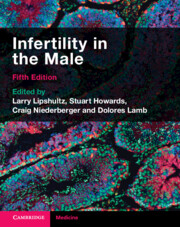23 results
Section 4 - Treatment of Male Infertility
-
- Book:
- Infertility in the Male
- Published online:
- 08 July 2023
- Print publication:
- 15 June 2023, pp 399-502
-
- Chapter
- Export citation
Index
-
- Book:
- Infertility in the Male
- Published online:
- 08 July 2023
- Print publication:
- 15 June 2023, pp 541-566
-
- Chapter
- Export citation
Section 1 - Scientific Foundations of Male Infertility
-
- Book:
- Infertility in the Male
- Published online:
- 08 July 2023
- Print publication:
- 15 June 2023, pp 5-106
-
- Chapter
- Export citation
Section 2 - Clinical Evaluation of the Infertile Male
-
- Book:
- Infertility in the Male
- Published online:
- 08 July 2023
- Print publication:
- 15 June 2023, pp 107-328
-
- Chapter
- Export citation
Contributors
-
- Book:
- Infertility in the Male
- Published online:
- 08 July 2023
- Print publication:
- 15 June 2023, pp vii-x
-
- Chapter
- Export citation
Chapter 3 - Maturation and Function of Sperm
- from Section 1 - Scientific Foundations of Male Infertility
-
-
- Book:
- Infertility in the Male
- Published online:
- 08 July 2023
- Print publication:
- 15 June 2023, pp 39-61
-
- Chapter
- Export citation
Abbreviations
-
- Book:
- Infertility in the Male
- Published online:
- 08 July 2023
- Print publication:
- 15 June 2023, pp xiii-xviii
-
- Chapter
- Export citation
Section 3 - Laboratory Diagnosis of Male Infertility
-
- Book:
- Infertility in the Male
- Published online:
- 08 July 2023
- Print publication:
- 15 June 2023, pp 329-398
-
- Chapter
- Export citation

Infertility in the Male
-
- Published online:
- 08 July 2023
- Print publication:
- 15 June 2023
Section 5 - Health Care Systems and Culture
-
- Book:
- Infertility in the Male
- Published online:
- 08 July 2023
- Print publication:
- 15 June 2023, pp 503-540
-
- Chapter
- Export citation
Chapter 18 - Advanced Diagnostic Approaches to Male Infertility
- from Section 3 - Laboratory Diagnosis of Male Infertility
-
-
- Book:
- Infertility in the Male
- Published online:
- 08 July 2023
- Print publication:
- 15 June 2023, pp 348-362
-
- Chapter
- Export citation
Contents
-
- Book:
- Infertility in the Male
- Published online:
- 08 July 2023
- Print publication:
- 15 June 2023, pp v-vi
-
- Chapter
- Export citation
Introduction
-
-
- Book:
- Infertility in the Male
- Published online:
- 08 July 2023
- Print publication:
- 15 June 2023, pp 1-4
-
- Chapter
- Export citation
Foreword
-
- Book:
- Infertility in the Male
- Published online:
- 08 July 2023
- Print publication:
- 15 June 2023, pp xi-xii
-
- Chapter
- Export citation
Copyright page
-
- Book:
- Infertility in the Male
- Published online:
- 08 July 2023
- Print publication:
- 15 June 2023, pp iv-iv
-
- Chapter
- Export citation
14 - The Genetic Basis of Male Infertility
-
-
- Book:
- The Sperm Cell
- Published online:
- 25 May 2017
- Print publication:
- 25 May 2017, pp 208-229
-
- Chapter
- Export citation
2 - Spermatogenesis
- from Section 1 - Anatomy and physiology
-
-
- Book:
- Fertility Preservation in Male Cancer Patients
- Published online:
- 05 March 2013
- Print publication:
- 21 February 2013, pp 11-22
-
- Chapter
- Export citation
Contributors
-
-
- Book:
- Fertility Preservation in Male Cancer Patients
- Published online:
- 05 March 2013
- Print publication:
- 21 February 2013, pp vii-x
-
- Chapter
- Export citation
Chapter 41 - A look towards the future:
-
-
- Book:
- Infertility in the Male
- Published online:
- 19 May 2010
- Print publication:
- 24 September 2009, pp 642-653
-
- Chapter
- Export citation
Contributors
-
-
- Book:
- Infertility in the Male
- Published online:
- 19 May 2010
- Print publication:
- 24 September 2009, pp vii-x
-
- Chapter
- Export citation



